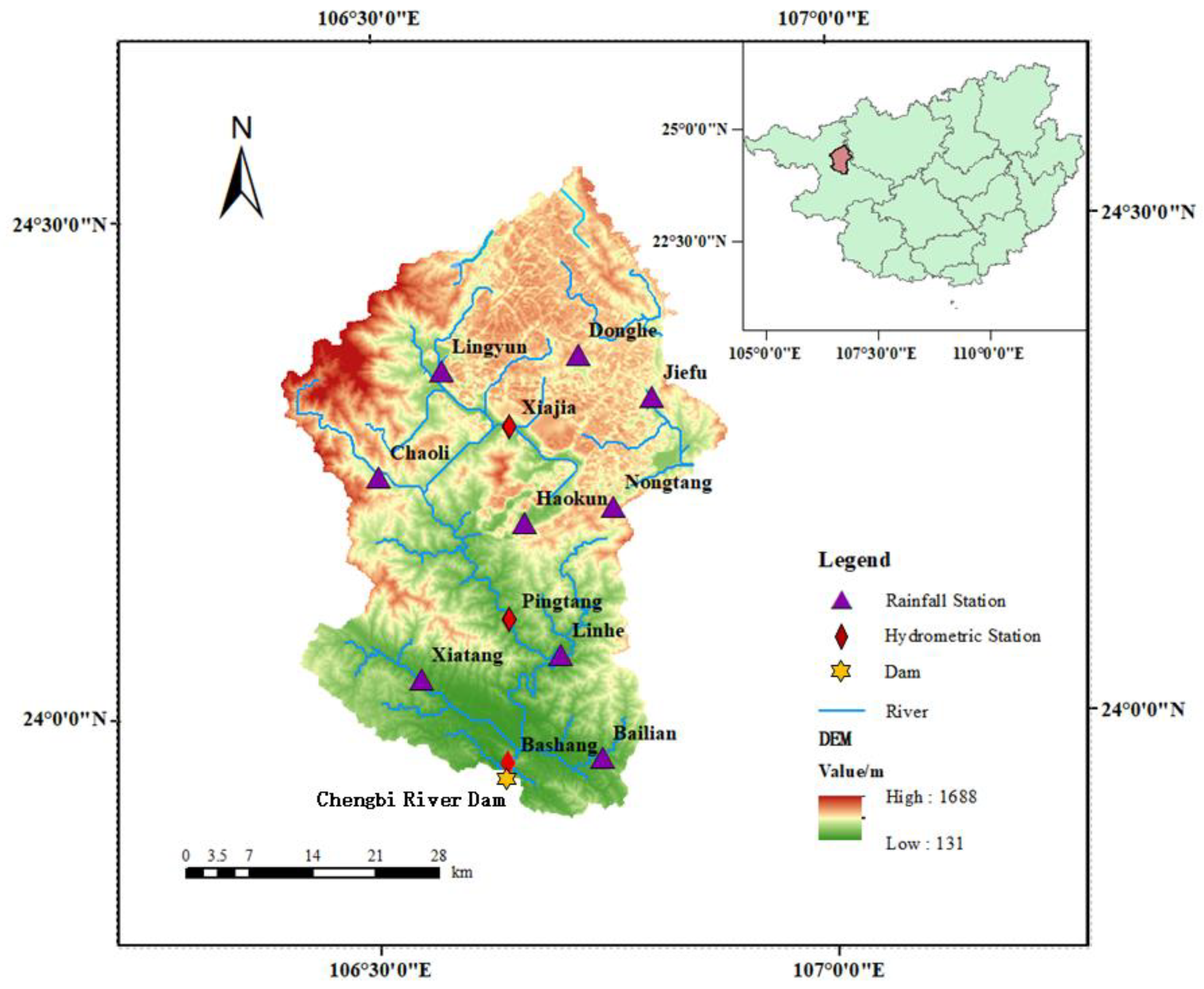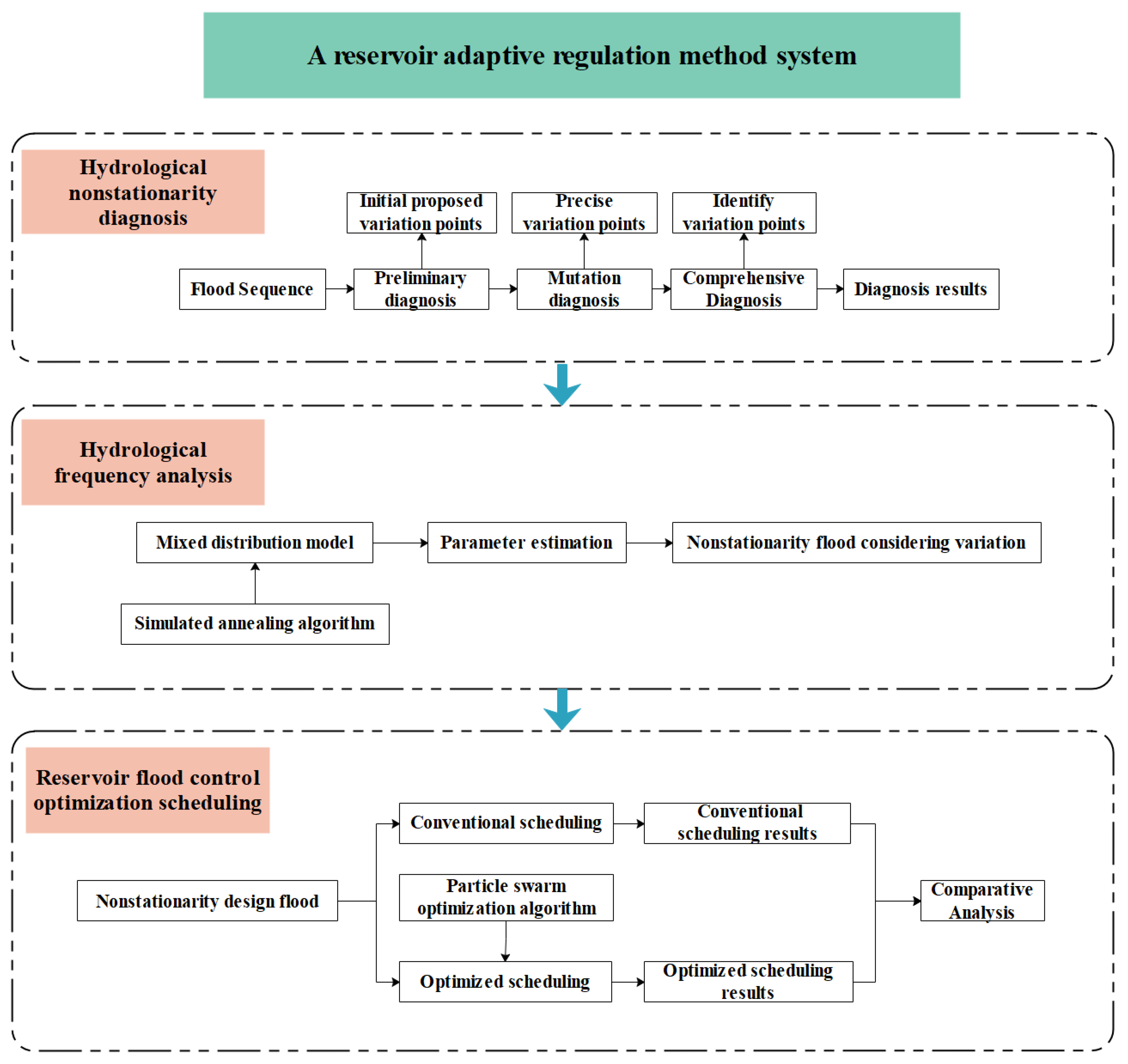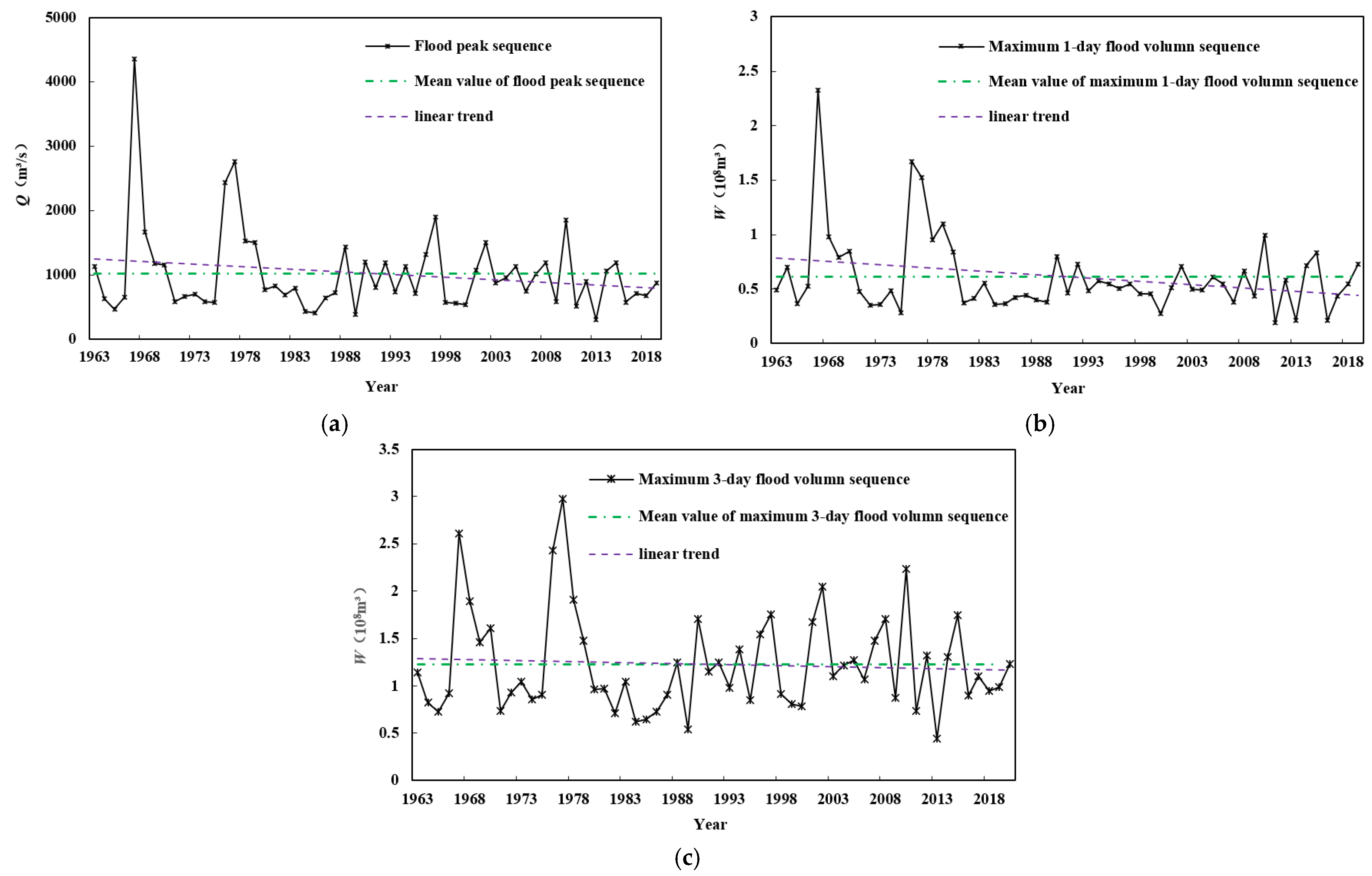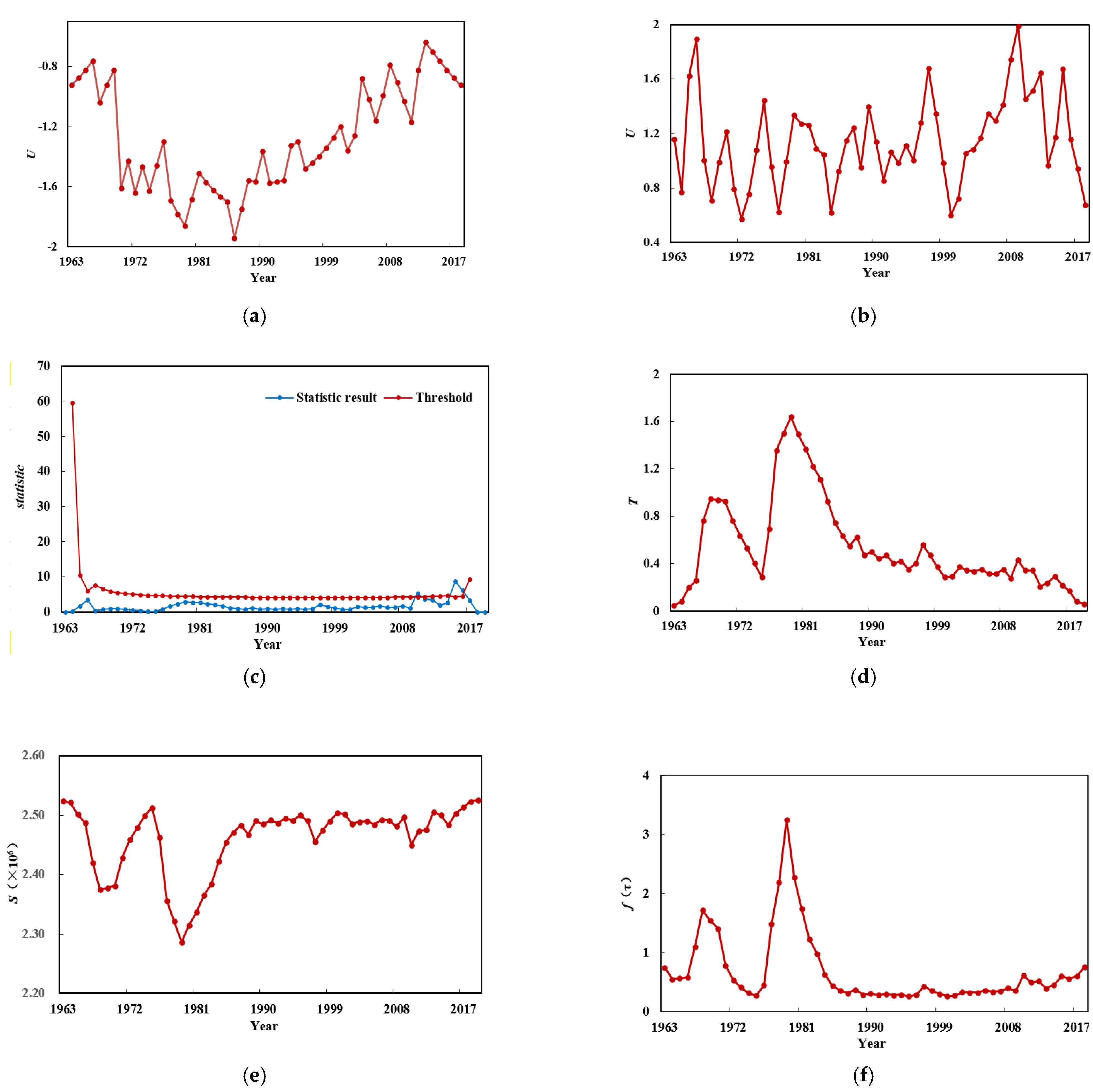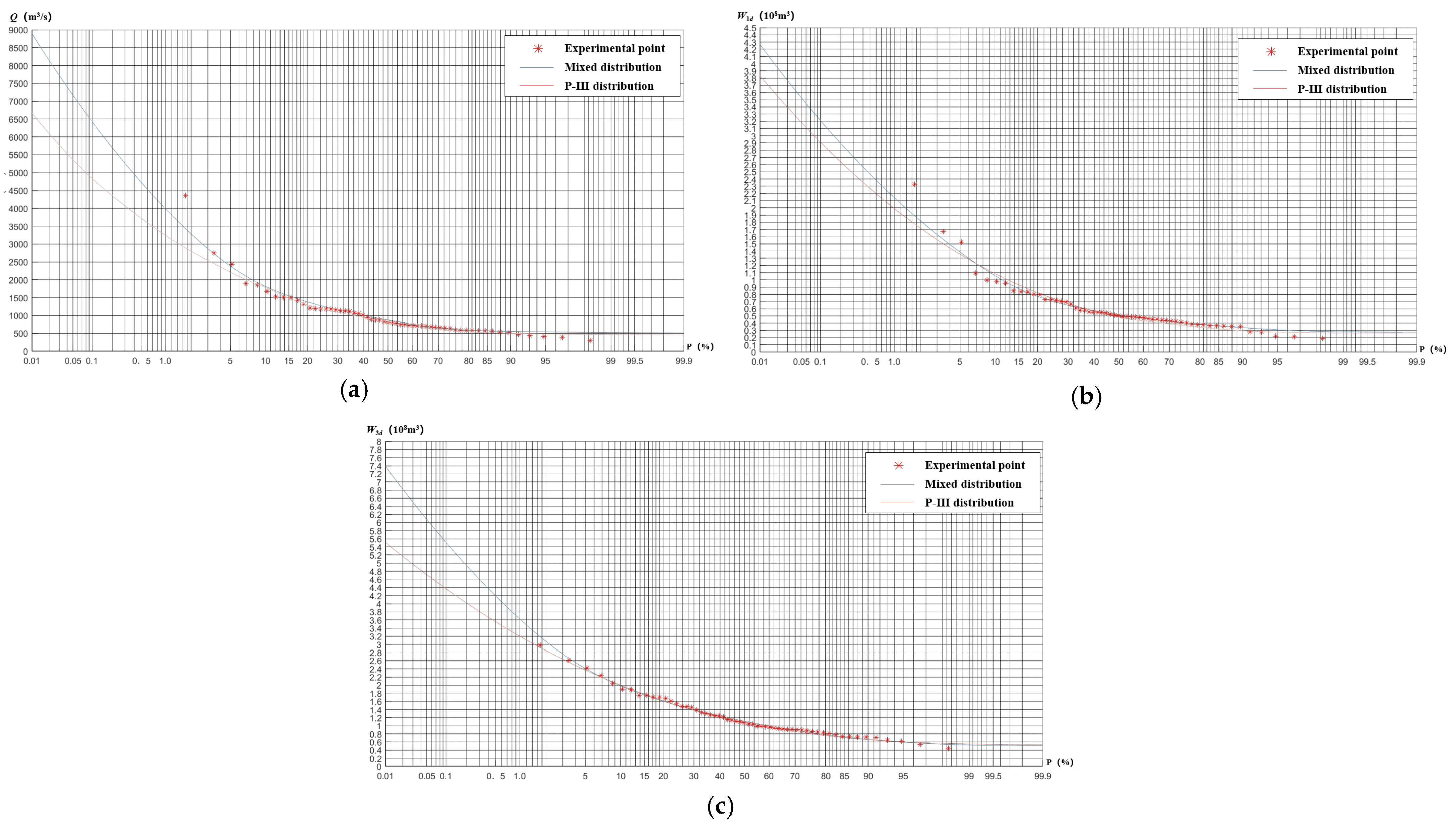1. Introduction
As one of the types of natural disaster that occur most frequently, cause the most serious damage, and have the widest impact globally, floods have undergone obvious alterations in frequency, spatial and temporal distribution, and severity under the influence of climate and sub-surface changes [
1]. In recent years, climate change and human activities have intensified, and hydrological conditions have changed significantly. The incoming flood sequences of many reservoirs no longer meet the assumption of stationarity, causing serious challenges for the original calculation methods of flood design, reservoir design, and operation scheduling. For instance, the use of traditional hydrological frequency calculation methods to analyze hydrological sequences under changing environmental conditions may result in less reliable calculation results and even the distortion of flood frequency design [
2,
3]. A reservoir scheduling plan created based on these results may lead to inadequate reservoir function or increase a reservoir’s safety risk due to the overestimation of the design’s ability to withstand flooding. Therefore, diagnosing hydrological non-stationarity characteristics, processing hydrological non-stationarity sequences, and establishing a scheduling method that adapts to non-stationary conditions and fully exploits the benefits of reservoir design are important issues that need to be addressed.
Diagnosing the variability in hydrological series, mainly through trend variability tests, mutation variability tests, and periodicity tests, is the first task to carry out in frequency analyses [
4]. In terms of mutation variability diagnosis, Pettitt’s method [
5], which was improved and refined by subsequent researchers, has become one of the most common methods used by scholars to find the mutation points of hydrological series. Inclan et al. [
6] proposed a mutation variability diagnosis model based on the ICSS model, which was applicable to independent time series and could be used to analyze multi-point mutation variability problems. Rodionov et al. [
7] classified common mean–mutation diagnostic methods into five categories: parametric or nonparametric test methods, curve fitting methods, CUSUM methods, and sequential analysis methods. Villarini et al. [
8] verified that Pettitt’s method did not require the assumption that the series obeyed a specific distribution, and their test results regarding flood frequency distribution in the Midwest of the United States were robust and reliable. Due to the instability of a single diagnostic method, Xie et al. [
9] constructed a hydrological variability diagnostic system from the statistical point of view that integrated trend and mutation variability, synthesized each diagnostic method by assigning weights, determined the year of variability and the variability form of a hydrological series by calculating the integrated weights and efficiency coefficients, and was then combined with physical cause analysis to finally arrive at diagnostic results. Hydrological variability diagnosis is commonly used as a stand-alone diagnostic method, which introduces a high degree of uncertainty into the results. The hydrological variability diagnostic system could greatly improve the reliability and accuracy of hydrological sequence variability diagnosis compared with a single diagnostic method.
Hydrological frequency calculation is closely related to the planning, design, operation, and management of water conservancy projects [
10]. Therefore, considering the severe challenge of applying the traditional hydrological frequency calculation method based on the consistency assumption, the need to determine a frequency calculation method applicable to non-stationary hydrological sequences is urgent. At present, the main methods for the frequency analysis of non-stationary hydrological sequences are the reduction, time-varying moment [
11], conditional probability model [
12], and mixed-distribution model methods. The mixed-distribution model method effectively avoids the shortcomings of the series-reconstruction-based method and is often used for calculating the frequency of non-stationary hydrological series with obvious seasonal characteristics and different physical causes. The early mixed-distribution model was simply a curve-fitting process. Potter et al. [
13] concluded in their study of flood frequency curves that the dog’s leg shape of the frequency curve was the result of flood series arising from different totals. Singh et al. [
14] used the mixed-distribution model method to analyze the frequency of about 600 flood series in the United States and other countries and considered the probability distribution of the observed flood series as a mixture of the probabilities of two log-normal distributions, thus improving the fit. The mixed-distribution model only became widely used in hydrologic frequency studies after 1992, when it was demonstrated and improved upon by Wang and Singh [
15]. Alila et al. [
16] applied the mixed-distribution method to the frequency analysis of a long series of floods in the Gila River Basin in central Arizona and introduced a means of selecting the most reasonable distribution function in flood frequency analysis. Cheng Jingqing et al. [
17] combined variational diagnosis theory and the hybrid distribution model method to analyze the frequency of runoff series in northern Shaanxi and Guanzhong, and the study showed that the mixed distribution model method was an effective way to analyze the frequency of non-stationary hydrological series. For most reservoirs, the design flood process is modeled using a hydrological frequency method based on the assumption of stationarity, which can limit the reservoir’s flood control function or increase the reservoir’s flood control risk [
18]. Therefore, the flood process must be modeled under changing environments based on a more reasonable hydrological frequency method, facilitating the flood control scheduling of reservoirs.
Reservoir flood control scheduling is necessary not only to ensure the safety of dams, but also to solve the problem of contradictions between the supply and demand of water resources. It is important to study methods of flood control scheduling for reservoirs in order to fully exploit reservoirs’ storage function; improve the benefits of reservoirs in terms of flood control, irrigation, and water supply; promote sustainable development; and reduce flood losses [
19]. According to various theoretical methods, flood control scheduling can be divided into conventional scheduling and optimal scheduling. Conventional scheduling typically uses the inlet flow or actual reservoir level as the criterion for determining reservoir discharge flow and formulates scheduling rules based on relevant management experience. This method is simple to implement and convenient to manage, but it cannot make full use of flood resources and has certain defects [
20]. However, optimal scheduling can coordinate various objectives of reservoir operation, which is crucial for safely operating and maximizing the benefits of reservoirs. For example, Foufoula et al. [
21] used a gradient dynamic planning method to design a scheduling model for the optimal scheduling of a reservoir group, which improved the accuracy of the calculation results. Oliveira et al. [
22] used genetic algorithms to develop improved scheduling rules in a reservoir scheduling study. Valeriano et al. [
23] combined a heuristic algorithm searching for the global optimal solution with a distributed hydrological model to effectively reduce the downstream flood flow, demonstrating the feasibility of heuristic algorithms in flood control scheduling applications. Trivedi et al. [
24] proposed a time-varying elite mutation multi-objective particle swarm optimization algorithm for the derivation and performance evaluation of optimal reservoir operation strategies. Ehteram et al. [
25] combined a bat algorithm with a particle swarm optimization algorithm to optimize the parameters of the Muskingum model for accurate flood scheduling in three case studies in the USA and UK. These studies effectively demonstrated that optimization algorithms could be used for the optimal scheduling of reservoir flood control but focused on stationarity flood processes.
In summary, many scholars have conducted research on hydrological non-stationarity diagnosis, hydrological frequency analysis, and reservoir flood control optimization scheduling and have produced abundant results. However, this study established an adaptive regulation method for reservoirs integrating hydrological non-stationarity diagnosis, hydrological frequency analysis, design flood calculation, and reservoir flood control optimization scheduling and applied it to research in Chengbi River Reservoir, aiming to quantitatively analyze the influence of human activities on floods in the basin and reduce the adverse effects of environmental changes on incoming floods by optimizing the scheduling methods of existing water conservancy projects in the basin. The purpose of this study was to propose a reservoir scheduling plan to maximize the flood control benefits under the current conditions and to ensure the expected benefits of the reservoir. To the best of our knowledge, few previous studies have combined hydrological non-stationarity diagnosis, hydrological frequency analysis, and reservoir flood control optimization scheduling to conduct research on the optimal scheduling of reservoir flood control under non-stationarity conditions, indicating that this paper has the potential to fill a significant research gap.
3. Methodology
In order to represent the approach of this study more accurately, a flow chart is shown in
Figure 3.
The main methods used in this study could be divided into three categories: (1) hydrological non-stationarity diagnosis methods, including preliminary, trend, mutation, and comprehensive diagnosis; (2) non-stationary flood sequence frequency analysis methods, including a mixed distribution model and a simulated annealing algorithm for non-stationary floods; (3) reservoir flood control optimization scheduling methods, including a reservoir flood control optimization scheduling model and particle swarm optimization algorithm. Due to limitations of space, only a few of these methods are briefly described below.
3.1. Hydrological Non-Stationarity Diagnosis Method
Hydrological non-stationarity diagnosis is a prerequisite for engineering design. First, the process line, sliding average, and Hurst coefficient methods were used to achieve a preliminary diagnosis of the hydrological sequences and determine whether they featured variations. If variability was identified, we had to further diagnose and analyze the mutability and trends. The trend diagnosis methods used in this study included the Spearman and Kendall rank order tests, and the mutability diagnosis methods included the sliding tour test, sliding rank sum test, Brown–Forsythe method, sliding t-test, ordered clustering method, and Lee–Heghinan test. After the results were obtained by the above methods, the most likely variation points were determined using the integrated diagnosis method.
3.1.1. Mutation Diagnosis
The purpose of mutation diagnosis is to identify the year in which the mutation of each sequence occurred. In order to enhance the persuasive power of variation identification, several tests with a higher weight in the traditional hydrological non-stationarity diagnosis system were selected in this study, including the sliding tour test, sliding rank sum test, Brown–Forsythe method, sliding
t-test, ordered clustering method, Lee–Heghinan test, sliding F-test, and Mann–Kendall method. By calculating the combined weights of the diagnostic results of each test, the year with the largest combined weight was determined as the most likely year of variation. The calculation formulae and weight coefficients of each test are shown in
Table 2.
3.1.2. Comprehensive Diagnosis
The comprehensive diagnosis was based on the conclusions of the trend and mutation diagnoses, combined with the analysis of the physical factors in the study area. Then, the heuristic segmentation algorithm was used to test and review the final variation points. The computational principle of the heuristic segmentation algorithm is briefly described below [
31].
For a time series
with sample size
and assuming the split point
, the combined deviation
for point
is calculated as
where
and
represent the numbers of sequences to the left and right of point
, respectively, and
and
represent the standard deviations of sequences to the left and right of point
, respectively.
In the above formula,
reflects the degree of difference between the left and right partial series means at point
, which is calculated as follows:
where
and
represent the averages of the left and right parts of the sequence at point
, respectively.
The larger the
value, the greater the degree of difference between the left and right sides of the series at that point.
denotes the statistical significance probability corresponding to the maximum value
for each
value, which is calculated as follows:
where
denotes the length of the sequence,
,
,
, and
is the incomplete
function.
3.2. Frequency Analysis Method for Non-Stationary Flood Sequences
Mixed Distribution Model and Simulated Annealing Algorithm
In 1991, Singh [
15], an American hydrological scientist, proposed the mixed distribution model, which has since been continuously improved and developed, gradually gaining the attention of domestic and foreign hydrologists, and is becoming widely used in flood frequency analysis under non-coherent conditions. The mixed distribution method is directly based on the extreme-value sample series of non-coherent distribution for frequency analysis, assuming that this extreme-value sample series comprises several sub-distributions with the following form:
where
are the cumulative probability distribution functions of the
sub-distributions, and
are the weight coefficients of each sub-series, satisfying
.
In order to reduce the complexity of parameter estimation, the general assumption is that the mixed distribution comprises two sub-distributions. Due to the paucity of measured hydrological series in this study area, one of the most significant mutations was considered, i.e., the hydrological series was divided into two sub-series. Therefore, a mixed distribution model containing two sub-series was used. The basic principle is explained below.
Consider the non-stationary flood sequence
with sample size
and its variation point location
. The total sequence
is divided into two sub-sequences,
and
, where the sample length of sub-sequence
is
and its probability density function is
; for sub-sequence
, the sample length is
and the probability density function is
. Then, the probability density function
of the total sequence
is
where
and
are the sub-series weight coefficients.
According to the ‘Specification for Calculation of Flood for Water Conservancy and Hydropower Engineering Design’ (SL44-2006) [
32], the hydrological variables had to be fitted with a Pearson type III (P-III) curve for distribution. Suppose that the sub-series
are subject to P-III distribution; then,
can be expressed as
Thus, the formula for calculating the theoretical frequency of the mixed distribution over the system frequency could be expressed as
The parameters , and could be expressed by the mean value of the statistical parameter , the coefficient of variation , and the bias coefficient , which were calculated as follows: . It followed that the parameters to be estimated in the mixed distribution model were , and.
The simulated annealing algorithm is highly suitable for finding the approximate global optimal solution of combinatorial optimization problems due to its robustness and simplicity of use [
33]. As shown in Equation (8), seven parameters had to be estimated in the mixed distribution model. The simulated annealing algorithm was used to solve the mixed distribution model, and the measured hydrological data of each hydrological station in the Chengbi River Basin were combined to determine a
value variation range of [2.5, 3.5] as the constraint and the absolute values of the frequency deviation and minimum frequency as the objective function to estimate the model parameters [
17,
34].
3.3. Reservoir Flood Control Optimization Scheduling Method
3.3.1. Reservoir Flood Control Optimization Scheduling Model
The purpose of reservoir flood control scheduling is to maximize the use of a reservoir’s flood control capacity and minimize the damage caused by flooding in the downstream protection zone while safeguarding the safety of the dam [
35]. In this study, according to the requirements of Chengbi River Reservoir, a maximum peak reduction model for the optimal flood control scheduling of Chengbi River Reservoir was established to reduce the adverse effects of environmental changes on the variations in incoming flood water. The maximum peak reduction model was designed to ensure the safety of the areas downstream of the reservoir by minimizing the flood peak in the reservoir. Its main aim was to fully exploit the storage capacity of the reservoir in order to reduce the maximum outflow [
36].
- (1)
Objective function.
When no interval entry flow exists:
When interval entry flow exists:
Here, is the reservoir discharge flow at time (m³/s); is the interval flood (m³/s); and is the total number of time periods in the whole scheduling process.
- (2)
Constraints.
- (a)
Water balance equation constraints:
where
is the storage volume at
(m
3),
is the average inlet flow of the reservoir at
(m³/s),
is the average discharge flow of the reservoir at
(m³/s),
is the storage volume change time (h), and
is the storage volume at
(m³).
is the reservoir loss flow during the considered time period (m³/s), which generally includes seepage and evaporation from the reservoir; however, since the actual reservoir loss flow was very small, it could be ignored in the flood calculations.
- (b)
Reservoir water level constraint:
where
is the lowest water level allowed in the dispatching process, i.e., the dead water level of the reservoir (m);
is the dispatching water level at time
(m); and
is the highest water level allowed in the dispatching process of the reservoir (m). In reservoir flood control and scheduling, the maximum allowable water level
for floods of different frequencies takes different values. The maximum allowable water levels in the Chengbi River Reservoir are 187.96 m under the 1000-year flood conditions and 189.29 m under the 10,000-year flood conditions.
- (c)
Reservoir discharge capacity constraint:
where
represents the average value of the outflow at time
(m³),
is the average value of the reservoir level at time
(m), and
is the maximum discharge flow (m³).
- (d)
Flood safety constraints downstream of the reservoir:
where
is the reservoir discharge at time
(m³), and
is the safe discharge for downstream flood control (m
3).
If the reservoir discharge flow is greater than the allowable discharge flow for downstream flood control, this will pose a threat to downstream safety. Reservoir safety takes precedence in the flood control scheduling process, and exceeding the safe discharge amount for downstream flood control should be avoided as far as possible under the premise of ensuring dam safety; otherwise, it may cause more considerable losses downstream. Therefore, the flood safety constraint is not a hard-and-fast constraint and should be considered on a case-by-case basis.
- (e)
Variation constraint of outgoing flow rate.
In order to prevent the downstream water level from falling too fast and generating landslides, the fluctuation in the downstream flow during and proceeding/following flood control scheduling should be moderated.
- (f)
Flood control reservoir capacity constraints.
The total amount of water stored in the reservoir for flood control must be lower than the flood control capacity of the reservoir during the scheduling process.
- (g)
Non-negative constraint.
All variables in the model must be non-negative.
3.3.2. A PSO Algorithm for Flood Control Operation
In this study, the particle swarm optimization algorithm was used to solve the previously proposed optimal flood control scheduling model. The discharge flow process
was regarded as the decision variable. The PSO algorithm was first proposed by Kenny and Eberhart [
37] based on the principle of bird flock foraging. In the process of bird flock foraging, each bird is considered as a searching particle flying in a
D-dimensional search region, and
m particles are randomly initialized, whose position vector
is one of the solutions of the searching process. The distance between this position and the global optimal solution can be expressed by the particles’ fitness values. The lower the fitness value, the more effective the solution. From the fitness values of the particles, the optimal particle of the population
is calculated, as well as the optimal position of each particle
. The particles are randomly initialized, and each assigned a certain velocity, i.e.,
; then, the particles complete one searching step in the search space. After the search is completed, the fitness value of each particle is calculated again, and the optimal solutions of both the population and the individual particles are updated [
38]. Finally, the velocity and position of the updated population and particles are calculated. Taking the maximum clipping model as an example, the fitness function of a particle aims to minimize the value of the leakage flow, i.e., Equation (15). The velocity and position update equation is presented in [
39]:
where
and
are random numbers in the range of 0 to 1;
and
are non-negative constants called learning factors, which usually take a value of 2.0;
is the individual optimal solution of particle
after
iterations,
;
is the optimal solution of the population after
iterations,
; and
is the inertia weight.
Then, the search continues, and the iterations are continuously updated until the optimal solution is reached.
5. Discussion
5.1. Similarities and Differences
This study established an adaptive reservoir regulation method integrating hydrological non-stationarity diagnosis, hydrological frequency analysis, design flood calculation, and reservoir flood control and optimization scheduling. We also conducted a case study in Chengbi River Reservoir, aiming at quantitatively analyzing the influence of human activity on floods in the basin in order to reduce the adverse effects of environmental changes on incoming floods by optimizing the scheduling of existing water conservancy projects in the basin. Hence, we proposed a reservoir scheduling scheme that maximized flood control benefits under the current conditions and guaranteed the expected benefits of the reservoir.
The non-stationary flood peaks, etc., calculated while considering mutations, were all higher than those under the original design, leading to an increased risk of flood control downstream, in contrast to the results of other basin studies. Li et al. [
40] used four mutation tests, namely, the linear trend correlation coefficient, Mann–Kendall test, sliding t-test, and Pettitt test, to examine the maximum flow from 1950 to 2006 at three hydrological stations in the Iloilo River Basin. The trends and mutations of the series were identified, and the time-series decomposition synthesis method was used to re-fit the design flood series. Chen et al. [
41] used the TFPW-MK mutation test and rank sum test to diagnose the variability of the hydrological series at Lanzhou, a representative station in the upper reaches of the Yellow River, and compared the natural runoff series with the measured runoff series to obtain the analysis results. The results showed that the hydrological series of Lanzhou station after the variation point of 1985 presented a significant decreasing trend, and the natural runoff series demonstrated high hydrological variability. For watersheds with significant decreasing trends in their hydrological series, such as the Yellow River [
41] and Haihe River [
42] basins in northern China, which are water-scarce areas, the main goal of adaptive scheduling should be to increase the use of flood resources through adaptive scheduling when this hydrological variability leads to water shortages. The Chengbi River Reservoir represents a case of hydrological variability leading to increased design flood and increased flood control risk, and so the main objective of adaptive scheduling should be to reduce the flood control risk generated by the hydrological variability. This provides a useful reference for flood-control-oriented basins.
The optimal scheduling results were more effective than the conventional scheduling results, which was consistent with the results of previous studies. Ren et al. [
43] used an improved genetic algorithm to optimize flood control scheduling during floods using the Fuziling Reservoir in the Pi River Basin as an example and compared the results with the 2020 flood control scheduling scheme for large reservoirs. The results showed that the design of the original scheduling scheme had certain limitations, and the scheduling results obtained by the optimization algorithm used up as little of the flood control capacity as possible while ensuring the safety of the reservoir and its downstream areas. Conventional scheduling generates scheduling rules based on relevant management experience, providing simplicity and convenience in terms of operation and management, but it does not enable flood resources to be fully exploited. In contrast, optimal scheduling can coordinate the various objectives of reservoir operation, which is crucial for safe operation and the maximization of benefits.
The simulated annealing algorithm is relatively easy to implement, requiring only the generation of new states through random transformations and the computation of objective function values, whereas the particle swarm optimization algorithm requires the tracking of the position and velocity of each particle, which can be much more computationally intensive. Therefore, the simulated annealing algorithm is usually more advantageous when dealing with large-scale optimization problems. Thus, the simulated annealing algorithm was used to solve the mixed distribution model. The PSO algorithm is widely used to solve reservoir optimization and scheduling problems because of its simple structure, limited number of parameters, and low computational requirements.
In previous studies, several scholars have proposed hydrological frequency analysis methods for changing environments. Some scholars have adjusted the reservoir scheduling rules in their study basin and implemented optimal scheduling. Other scholars have proposed new optimal flood control scheduling methods for changing environments, but few have combined these methods. In this study, a system of adaptive reservoir regulation methods integrating hydrological non-stationarity diagnosis, hydrological frequency analysis, design flood calculation, and reservoir flood control optimization scheduling was established.
5.2. Policy Recommendations
Under the influence of climate change and human activities, considering the inconsistency of flood sequences and the influence of reservoir engineering on storage, developing calculation methods for reservoir design floods under a changing environment and deducing reasonable reservoir design flood processes can not only improve our understanding of design flood calculation under variable conditions but also provide data support for flood control planning and the operation scheduling of reservoir engineering. Therefore, hydrologists should carry out research on flood frequency analysis under non-stationary conditions to understand the influence of the changing environment in the basin. Reservoir managers should improve reservoir scheduling schemes to maximize the benefits of reservoirs. In addition, smaller reservoirs could be built on each tributary of the Chengbi River to reduce the hydrological impact when flooding occurs.
5.3. Innovation, Limitations, and Further Research
This study established an adaptive reservoir regulation method integrating hydrological non-stationarity diagnosis, hydrological frequency analysis, design flood calculation, and reservoir flood control optimization scheduling. We aimed to quantitatively analyze the influence of human activities on floods in the Chengbi River Basin, reduce the adverse effects of environmental changes on incoming floods by optimizing the scheduling of existing reservoirs in the basin, and propose a reservoir scheduling scheme that maximized flood control benefits under the current conditions to ensure the expected benefits of reservoirs.
The restricted availability of information limited our research process, and this study could be further improved and expanded in the following directions in future research: Regarding the hydrological frequency analysis, we only performed univariate frequency analysis for non-stationary floods under changing environments; however, flood events are complex and variable, and flood frequency analysis based on multivariate joint distribution could fully elucidate the correlations between each characteristic variable and more accurately describe the evolutionary patterns of flood events. We could use multivariate joint-based flood frequency analysis to understand complex and variable flood events. Regarding reservoir flood control optimization scheduling, we only studied the flood control scheduling of Chengbi River Reservoir. The joint scheduling of upstream and downstream projects combining upstream reservoirs and multiple objectives, such as water supply, flood control, power generation, and irrigation, needs further study.
6. Conclusions
Due to the strong influence of climate change and human activities, the vast majority of reservoirs’ incoming flood sequences no longer meet the consistency assumption. Continuing to adopt the scheduling rules formed during reservoir design often makes the full exploitation of reservoir design functions and benefits difficult and may even increase flood control risks. To this end, we proposed a system of adaptive reservoir regulation and control methods integrating hydrological non-stationarity diagnosis, hydrological frequency analysis, design flood calculation, and reservoir flood control optimization scheduling and applied it to Chengbi River Reservoir. The main conclusions obtained from this study are summarized below.
From the hydrological variability diagnosis results, we concluded that the annual flood peak sequence and the annual maximum 1- and 3-day flood sequences featured mutations. The use of a hydrologic non-stationarity diagnostic system combined with physical causation analysis more accurately identified variability in the flood sequences than a single diagnostic method. The calculation process of the non-stationary flood frequency analysis based on mixed distribution took into account the hydrological conditions under the changing environment, and the non-stationary design flood results obtained considering the point of variability were closer to reality. The particle swarm optimization algorithm scheduling of reservoir flood control under non-stationary conditions allowed the full exploitation of reservoir flood regulation and reduced the downstream flood control pressure.
In future work, we could use multivariate joint-based flood frequency analysis to cope with complex and variable flood events. Furthermore, we could also combine upstream and downstream reservoirs and multiple objectives, such as water supply, flood control, power generation, and irrigation, to conduct joint scheduling studies. Finally, smaller reservoirs could be built on each tributary of the Chengbi River to reduce the hydrological impact when flooding occurs.
